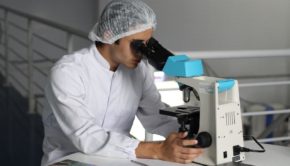New solar-powered device has promising potential to clean up water-polluting dye
Can solar energy be used for filtering water? New research from UK shows that it is possible.
A recent study, led by scientists Charles W. Dunnill and Daniel Jones at the Energy Safety Research Institute (ESRI) at Swansea University, details a novel photon-absorbing device that can convert sunlight into energy and breakdown synthetic dye pollutants in the water system. The invention can eventually be used to clean up our water supply for drinking.
For factories like textile mills and cosmetic and pharmaceutical sector, dye production is inevitable as part of the production routine. Much of the dye end up in local water resources and drain into the ocean. These synthetic pollutants are harmful for marine life and can inhibit important aquatic processes like marine photosynthesis; for example, reducing the amount of sunlight algae need to produce nutrient and oxygen.
Unfortunately, dye pollutants are non-degradable in nature, which means they tend to remain in the water if left untreated. According to the latest Nature report, 300,000 tons of dye are passed into the world’s water supply each year at a time when fresh drinking water is much needed. For many global communities, eliminating these pollutants has become an urgent matter.
Dr. Dunnill and his team at ESRI believe they have found a promising solution to clean up water systems: a non-toxic catalyst that uses sunlight to degrade dye pollutants. The photocatalytic invention is made up of two layers of photon-absorbing metal oxides–tantalum nitride and tungsten oxide–and uses solar energy to alter the chemical structure of dye. Though such materials have previously been researched, according to the researchers, this is the first time such a device can take advantage of the entire visible spectrum of sunlight, leading to more efficient dye degradation.
Self-powering device that can degrade dye pollutants
The researchers created their photocatalytic device by first making a powdered form of tantalum nitride through a process of grinding and heating tantalum chloride, sodium chloride, and potassium chloride. Then they grew ultra-thin nanowires of tungsten oxide onto the surface of tantalum nitride using a solvothermal technique that’s similar to growing nanocrystals. The resulting synthesis is no bigger than 40 billionth of a meter in diameter and has a large surface area that effectively collects dye and turns it into to biodegradable water, carbon dioxide, and mineral byproducts.
The underlying science behind their dye-degrading device is this: Photons from the sun reach the first layer of the semiconducting composition, causing charges to separate into negative electrons and positive holes; the second semiconductor prevents the charges from recombining. The end result is more electron transferring across the semiconductors.
The associated high amount of energy and electrons created by the device is what allows for the reconstruction molecular structures; for instance, adding an extra electron to a molecule in the redox process or taking an electron away from it in oxidation. Both chemical reactions are responsible for turning dye pollutants into simple, biodegradable ones.
The new photocatalytic device is stated to be able to absorb 90% of dye pollutants at 10 times faster that its predecessors. The two-layered device gives you more energy with which to breakdown the pollutants, explained Dr. Dunnill. This is due in part to enhanced properties in the two chosen materials. Tungsten oxide has high electrical conductivity, surface activity, and light absorbing properties; tantalum nitride is a low band-gap semiconductor that is able to absorb almost the entire visible spectrum. When sandwiched together, the semiconductors create what the ESRI team believes to be the most efficient dye remover today.
Dr. Dunnill also revealed that the device will be purposed to supply more drinking water. “I would envisage that the technology would be used to clean runoff water from factories before discharge into the rivers,” said Dr. Dunnill, “or to clean unsafe drinking water prior to drinking in hot countries.” His team is currently working on scaling up the device for real-world applications. It’s also worthy to note that this photocatalytic composition is non-hazardous in nature, so it can simply be filtered out of cleaned water for reuse.
Could a commercialized version be used to clean up the ocean? The research team has not tested this. “The technology is more about cleaning drinking water than sea water,” said Dr. Dunnill, though they are hopeful. “I am not aware of any scientific reason for it not working equally well.”















